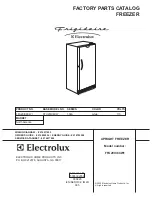
11
dar. Opened jars and bottles of salad dressings, sauces and jams.
Fats, eg. Butter, margarine, low-fat speads, cooking fats and lard.
Coldest area: 2
℃
to 5
℃
This is where foods which must be cold to keep them safe should
be kept:
• Raw and uncooked foods should always be wrapped.
• Pre-cooked chilled foods, eg. Ready meals, meat pies, soft
cheeses.
• Pre-cooked meats eg. Ham,
• Prepared salads(including pre-packed mixed green salads, ri-
ce, potato salad etc).
• Desserts, eg. Fromage frais, home-prepared food and lef-
tovers or cream cakes.
Salad bin
This is the most humid part of the Fridge. Vegetables, fruit, fresh
salad items eg. Unwashed whole lettuce, whole tomatoes, rad-
ishes etc can be stored here.
WE RECOMMEND THAT ALL PRODUCE KEPT IN THE SALAD BIN
IS WRAPPED.
NOTE
:
Always wrap and store raw meat, poultry and fish on the
lowest shelf at the bottom of the fridge. This will stop them drip-
ping onto, or touching other foods. Do not store inflammable
gasses or liquids in the fridge.
Tips for shopping for frozen foods
Your Freezer is 4 star
When you are buying frozen food, look at the Storage Guidelines
on the packaging. You will be able to store each item of frozen
food for the period shown against the 4 star rating. This is usually
the period stated as “Best, Before”, found on the front of the
packaging.
Check the Fridge/Freezer temperature
Check the temperature of the frozen food cabinet in the shop
where you buy your frozen foods. It should show a temperature
lower than -18
℃
.
Choose packs carefully
Make sure the frozen food package is in perfect condition.
Purchase frozen food last
Always buy frozen products last on your shopping trip or visit to
the supermarket.
Keep frozen foods together
Try to keep frozen food together whilst shopping, and on the
journey home as this will help to keep the food cooler.
Store food straight away
Don’t buy frozen food unless you can freeze it straight away.
Special insulated bags can be bought from most supermarkets
and hardware shops. These keep frozen food cold for longer.
Thawing frozen food
For some foods, thawing before cooking is unnecessary. Vegeta-
bles and pasta can be added directly to boiling water or steam
cooked. Frozen sauces and soups can be put into a saucepan and
heated gently until thawed.
Freezing fresh foods, useful tips
Use quality food and handle it as little as possible. Freeze food in
small quantities, it freezes faster, takes less time to thaw and en-
ables you to eat it in the quantity you need.
Freezing fresh foods
First, estimate the amount of food you will be freezing. If you are
freezing large amounts of fresh food, remember to turn the con-
trol dial to Max. This will lower the temperature in the Freezer
(approx -30
℃
), freezing your food quicker and helping to keep
the goodness in. However you should do this sparingly to con-
serve energy.
Preparations for freezing
Leave cooked food to cool completely.
Chill food in a Fridge before freezing if possible.
Consider how you want to cook the food before freezing it.
Don’t freeze food in metal containers as you may want to mi-
crowave it straight from the Freezer.
Use special Freezer bags available from supermarkets, Freezer
film, polythene bags, plastic containers, aluminum foil for acidic
foods(such as citrus fruits).
Do not use thin cling film or glass. Do not use used food contain-
ers (unless cleaned thoroughly first).
Exclude as much air from the container as possible. You could
buy a special vacuum pump which sucks excessive air out of the
packaging.
Leave a small amount of “air space” when freezing liquids, to al-
low for expansion.
You can use the space in the Freezer most efficiently if you
freeze liquids(or solids with liquids, such as stew) in square
blocks.
This is known as “performing” Pour the liquid into a polythene
bag which is inside a square sided container. Freeze it like this,
then remove it from the container and seal the bag.
Defrosting
This appliance is designed as automatic defrosting ,no need to
defrost by hand.













































